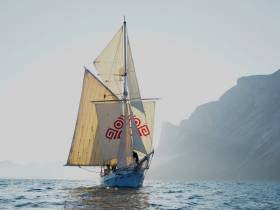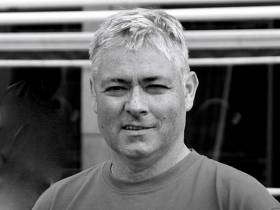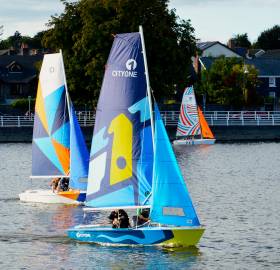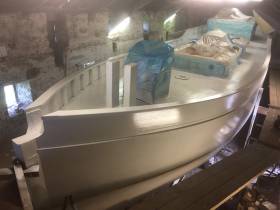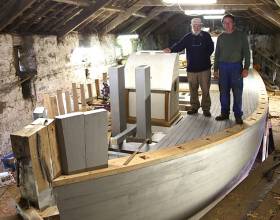Displaying items by tag: Gary MacMahon
Twenty years ago, the thought that the two Conor O’Brien-designed and Baltimore-built ketches – the 1922 42ft world-girdling Saoirse and the 1926 56ft trader-ferry Ilen - would be sailing together at their birthplace in 2023, the Centenary Year of the start of O’Brien’s great pioneering circumnavigation, would have been dismissed as a magnificent but total fantasy. Yet the plans for this unprecedented occurrence are well in place for the Baltimore Wooden Boat Festival from May 26th to 28th. And while the re-restoration or re-birth of the two vessels may have involved many people, pivotal to it all has been one man, Gary Mac Mahon of Limerick, who devoted 27 years to bringing this all together.
 The restored Ilen during a visit to Galway
The restored Ilen during a visit to Galway
His mission achieved, he has now stepped back from direct involvement. But the Irish sailing community – and indeed sailing throughout the world – will be for ever grateful to him, and he is our very worthy Afloat.ie “Sailor of the Month” for April 2023.
 The re-born Saoirse on a trial sail at Baltimore in February 2023. For convenience of sail handling in short-passage use, owner Fred Kinmonth has retained the main-boom as fitted by later owners. But during the round the world voyage south of the Great Capes in 1923-25, Saoirse sailed with a loose-footed mainsail
The re-born Saoirse on a trial sail at Baltimore in February 2023. For convenience of sail handling in short-passage use, owner Fred Kinmonth has retained the main-boom as fitted by later owners. But during the round the world voyage south of the Great Capes in 1923-25, Saoirse sailed with a loose-footed mainsail
The Ilen’s Gary Mac Mahon & Paddy Barry are Sailors of the Month (Cruising) for September
The long story of the re-birth of the 1926-built 56ft Conor O’Brien trading ketch Ilen of Limerick was acquiring an almost wraith-like aspect until in 2019 – the restoration job completed – she undertook the very tangible 5000 miles Salmons Wake voyage to Greenland for inter-cultural exchange, research into salmon migration, and data-acquisition on climate change. Project Director Gary MacMahon – whose unflinching faith has kept this extraordinary concept moving ahead – was skipper for the outward passage from Ireland, whiled seasoned voyager Paddy Barry – who was aboard throughout the time away from Ireland – brought Ilen home safely across the restless North Atlantic in unsettled early Autumn conditions.
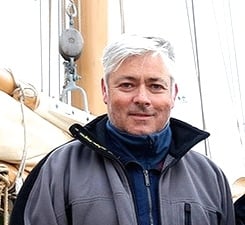 Gary Mac Mahon aboard Ilen in Nuuk – his sustained vision resulted in the restored Ilen’s successful voyage to Greenland. Photo: Chelsea Canavan
Gary Mac Mahon aboard Ilen in Nuuk – his sustained vision resulted in the restored Ilen’s successful voyage to Greenland. Photo: Chelsea Canavan A man of the sea and the mountains and the ice – Paddy Barry safely skippered Ilen home from Greenland across a restless Autumnal North Atlantic
A man of the sea and the mountains and the ice – Paddy Barry safely skippered Ilen home from Greenland across a restless Autumnal North Atlantic
Gary MacMahon of Limerick is Afloat.ie 'Sailor of the Month' for January
In the depths of this winter, traditional boat enthusiasts worldwide were thinking of Oldcourt in West Cork, where the traditional ketch Ilen, having completed her basic restoration, had to be moved in difficult and cramped conditions out of her building shed, using only minimal resources, in order to create space so that re-construction could begin on her more famous older sister, Conor O’Brien’s world-girdling Saoirse.
Many people have been involved in this project, both directly and in a supportive role. But the man who fulfilled the dream of bringing the retired Ilen home from the Falklands for restoration is Gary MacMahon of Limerick, and he has kept the flame of hope alive for twenty years through times thick and thin – sometimes very thin indeed.
 Gary MacMahon and the late Theo Rye with one of the CityOne dinghies which the latter designed for construction by the Ilen Boat-Building school in Limerick. Photo: W M Nixon
Gary MacMahon and the late Theo Rye with one of the CityOne dinghies which the latter designed for construction by the Ilen Boat-Building school in Limerick. Photo: W M Nixon
Despite the many challenges, the Ilen Project has developed to become a boat-building school in the heart of Limerick which has become part of an international craftsmen and student exchange network, while in its workshops instructors and trainees have built Shannon gandelows and several other traditional craft, as well as the novel CityOne sailing dinghies designed specially for the school by the late Theo Rye. In addition, they built new deckhouses and many other items for Ilen herself.
Meanwhile, in a co-ordinated operation at Liam Hegarty’s boatyard in Oldcourt, the restoration of Ilen’s hull had progressed to its final stages, and by January – with space cleared for the Saoirse and Ien safely re-positioned – it was evident that a new era had begun, a very timely reminder to celebrate and honour what Gary MacMahon and his supporters have achieved.
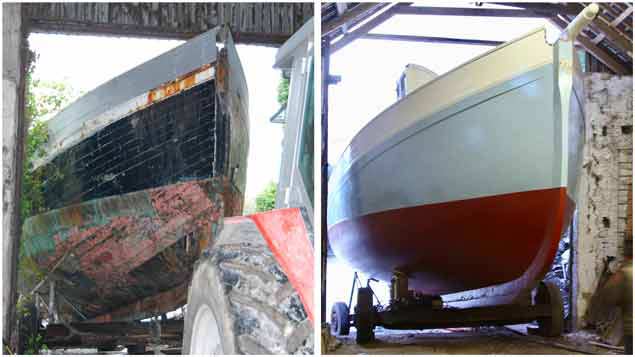 Ilen going into the shed for restoration (left) and as she was when she re-appeared for re-positioning in Oldcourt Batyard in January. Photos: Gary MacMahon
Ilen going into the shed for restoration (left) and as she was when she re-appeared for re-positioning in Oldcourt Batyard in January. Photos: Gary MacMahon
Historic Ketch Ilen’s Busy Workshop in Limerick Keeps the Baltimore Show on the Road
Many people have dropped by the Old Cornstore on the riverside at Oldcourt in West Cork to see work progressing on the restoration of the 1926 Conor O’Brien ketch Ilen writes WM Nixon. And naturally they’ll have the impression that they’re at the main scene of the action. After all, the 56ft vessel certainly looks the part - a complete ship, full of promise in her distinctive new colour scheme.
But as Gary MacMahon of the Ilen Boatbuilding School in Limerick points out, even with a hefty traditional vessel like Ilen, the finished hull with deck in place is only about 35% of the complete and fully commissioned vessel. And though the assembly of the various parts inevitably has to take place in Oldcourt with Liam Hegarty and his team, much of what you’re looking at on the Ilen today was actually built in the Ilen School’s efficient workshops in Limerick city.
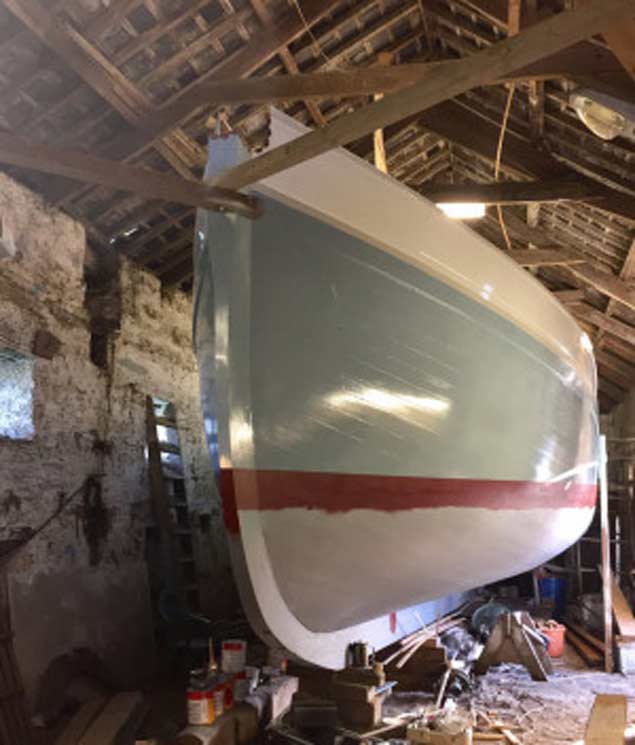 The Ilen herself in Oldcourt near Baltimore, newly painted and looking very well. Photo Ilen BS
The Ilen herself in Oldcourt near Baltimore, newly painted and looking very well. Photo Ilen BS
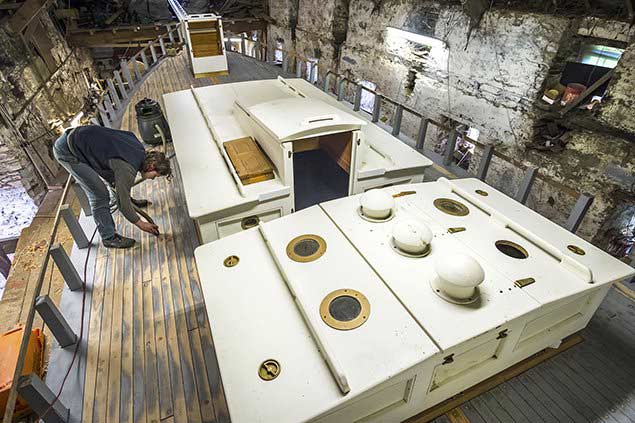 The new deckhouses, hatches etc on the Ilen were all made in Limerick. Photo Ilen BS
The new deckhouses, hatches etc on the Ilen were all made in Limerick. Photo Ilen BS
There, young people – indeed, people of all ages and from many backgrounds – are finding that working with wood, and creating parts for boats or building complete boats, is a profoundly interesting and fulfilling experience. In recent years, the Ilen School has turned out impressively authentic versions of the traditional Shannon gandelow, and in a completely different direction, sailing dinghies of the distinctive CityOne class to a very special design by the late Theo Rye.
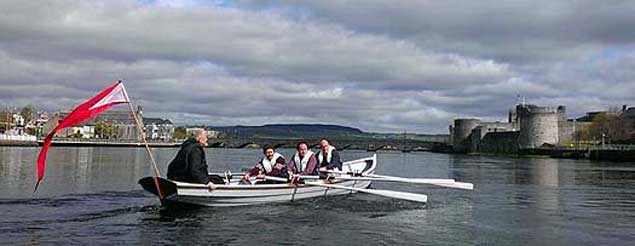 One of the Ilen Boatbuilding School’s traditional gandelows on the Shannon in Limerick, heading upriver towards King John’s Castle. Photo: Gary MacMahon
One of the Ilen Boatbuilding School’s traditional gandelows on the Shannon in Limerick, heading upriver towards King John’s Castle. Photo: Gary MacMahon
 It makes a change from the Shannon Estuary - the Ilen Boatbuilding School’s gandelows in Venice. Photos: Gary MacMahon
It makes a change from the Shannon Estuary - the Ilen Boatbuilding School’s gandelows in Venice. Photos: Gary MacMahon
These smaller craft have been imaginatively used by those who built them for various expeditions to events such as the Baltimore Woodenboat Festival and the Glandore Classics Regatta. And in 2014, the Gandelows somehow managed a remarkable double by taking part in the Thousandth Anniversary re-enactment of the Battle of Clontarf (wasn’t Brian Boru a Limerick man, after all?) and yet somehow also took in a Marine Festival in Venice, as it’s reckoned that the word “gandelow” originated from gondola, but mutated along the way.
Having taken such things and various other projects in their stride, the Ilen people in Limerick have enthusiastically lined up to build the deckhouses, hatchways, skylights, lignum vitae rigging deadeyes and many other items for Ilen herself. Each is an exquisite bit of marine joinerywork in its own right, and when fitted on the ship, they go so well with the overall concept that you’d be hard-pressed to guess that they were built many miles away, in the characterful city on Shannonside, rather than among the rolling green hills and woodland of West Cork.
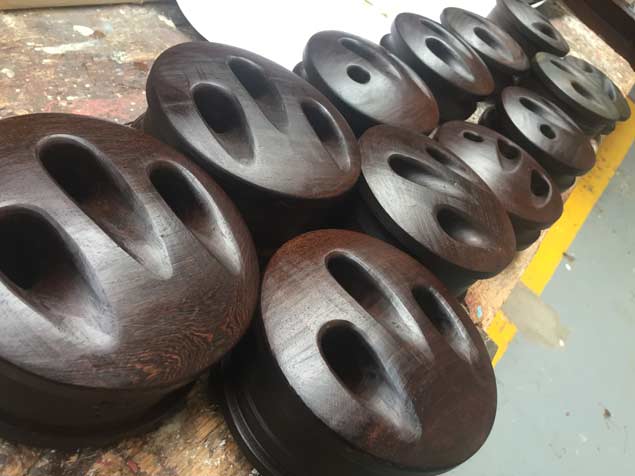 Deadeyes made in Limerick from rare lignum vitae – the word is that this very high density wood “was sourced from a former shipyard in Cork”. Photo: Gary MacMahon
Deadeyes made in Limerick from rare lignum vitae – the word is that this very high density wood “was sourced from a former shipyard in Cork”. Photo: Gary MacMahon
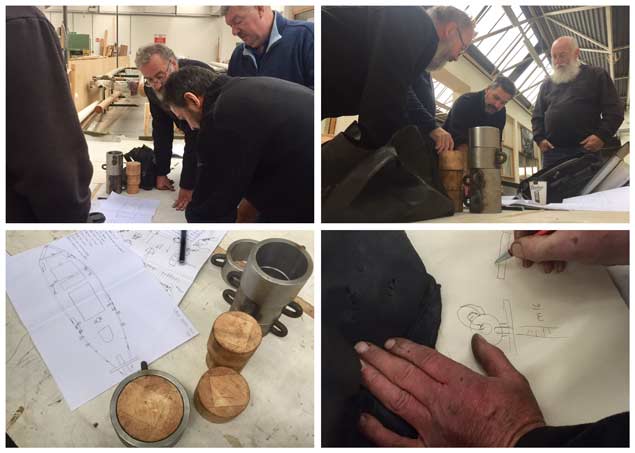 Group discussion in Limerick with Liam, Trevor, Pete and Robert to sort and assess items of rigging gear. Photos: Gary MacMahon
Group discussion in Limerick with Liam, Trevor, Pete and Robert to sort and assess items of rigging gear. Photos: Gary MacMahon
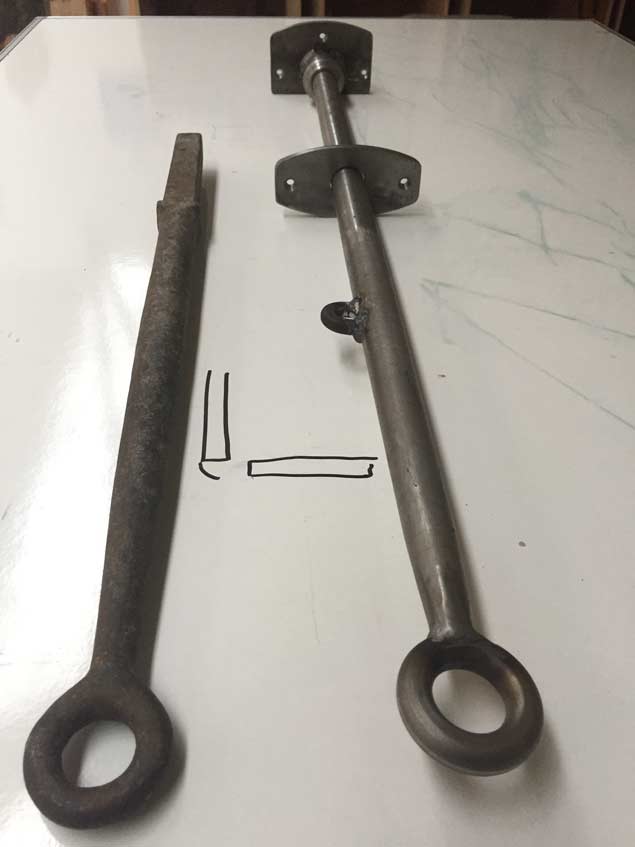 Modern safety requirements dictate that the original guard-rail stanchions (left) have to be replaced by longer ones (right) to provide one metre clearance. Photo: Gary MacMahon
Modern safety requirements dictate that the original guard-rail stanchions (left) have to be replaced by longer ones (right) to provide one metre clearance. Photo: Gary MacMahon
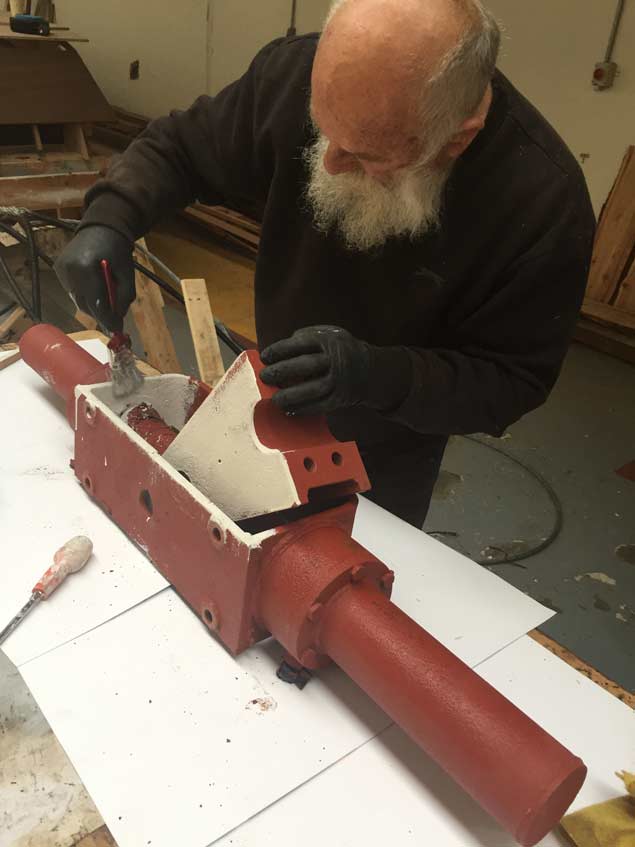 The hydraulic steering actuator is cleaned and serviced before being sent for pressure testing. Photo: Gary MacMahon
The hydraulic steering actuator is cleaned and serviced before being sent for pressure testing. Photo: Gary MacMahon
But such is the case, because for all his fondness for West Cork, Conor O’Brien’s spirit is in Foynes Island on the Shannon Estuary, and Limerick is his city, the city of the O’Briens since time immemorial. And recently, Limerick has been turning out the stanchions for the Ilen’s guard-rails, something which is well in line with the city’s engineering traditions. But most impressive of all is the final work on finishing the spars.
When Ilen was shipped back from the Falklands in 1998, some of her surviving spars were in a decidedly poor conditions. But the new Limerick-built replacements are robust works of art, with a natural functional beauty. It really will be a show on the road, and then some, when they’re taken on that winding journey from Limerick down to Baltimore.
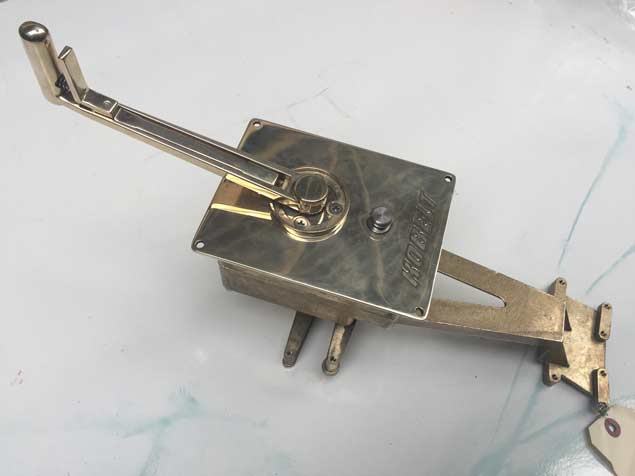 An authentic marine bronze Kobelt heavy duty engine control is sourced “by good fortune” – it cleans up a treat
An authentic marine bronze Kobelt heavy duty engine control is sourced “by good fortune” – it cleans up a treat
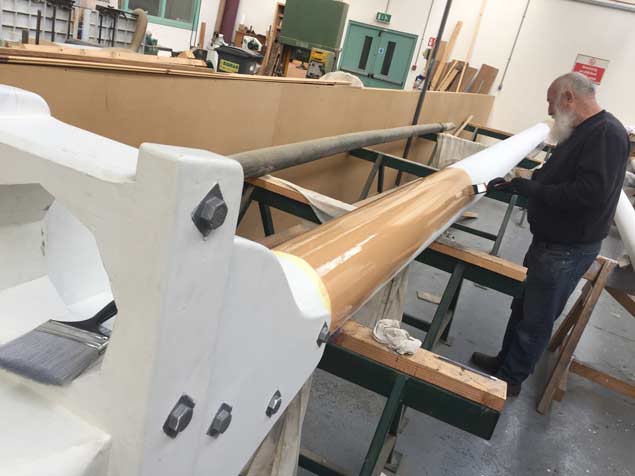 Finally getting there – Liam O’Donoghue gives Ilen’s new mainmast its finishing coats of paint – the special colour is “US Navy buff” Photo: Gary MacMahon
Finally getting there – Liam O’Donoghue gives Ilen’s new mainmast its finishing coats of paint – the special colour is “US Navy buff” Photo: Gary MacMahon
Ghost Ship Ilen is Haunting West Cork
When Gary MacMahon of Limerick brought the 57ft Conor O’Brien ketch Ilen back from the Falkland Islands in 1998, the 1927-built former inter-island trading and passenger transport vessel was in danger of becoming a ghost ship writes W M Nixon.
Since then, the long road of fund-raising and planning for this significant vessel’s useful future has taken time, but in due course a full restoration/rebuild was undertaken by Liam Hegarty and his master-shipwrights at Oldcourt. This most appropriately is on the Ilen River, just above Baltimore where Ilen was built to designs by Tom Moynihan and Conor O’Brien.
Work has progressed, and in recent days Ilen has entered an intensive painting stage to make best use of the dry atmospheric conditions of this unusually warm and sunny weather, which is some consolation for those of us who think the current meteorological phase is just too bright and hot altogether.
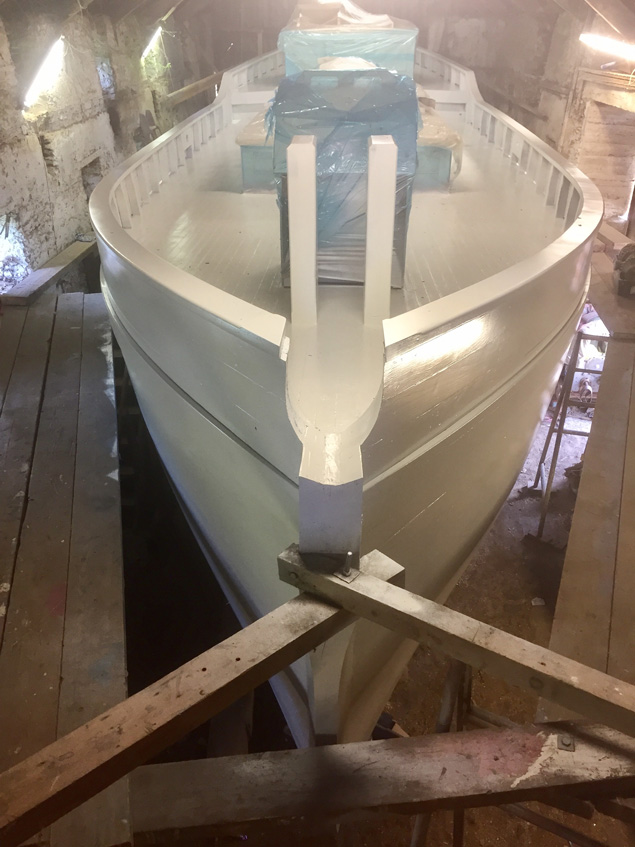 A-haunting we will go…..Ilen’s current paint state in Oldcourt’s Corn Store would make provide an ideal setting for a touch of the Bram Stoker’s. Photo: Gary MacMahon
A-haunting we will go…..Ilen’s current paint state in Oldcourt’s Corn Store would make provide an ideal setting for a touch of the Bram Stoker’s. Photo: Gary MacMahon
The application of the primer has resulted in her emerging in real ghost ship mode. What with the mist of from the painting work in Ilen’s current home in the Old Corn Store, and the overall blanking effect, the result is decidedly spooky.
But very soon the Ilen as she is going to be in her finished form will begin to emerge. Whether or not she will follow the people’s choice as revealed by the Afloat.ie Ilen Colour Poll on March 8th 2017 remains to be seen. Personally I would have inclined to the dark green if it could be complemented with a classic white boot-top. All will be revealed very soon. But for now, Ilen really is haunting Oldcourt Boatyard.
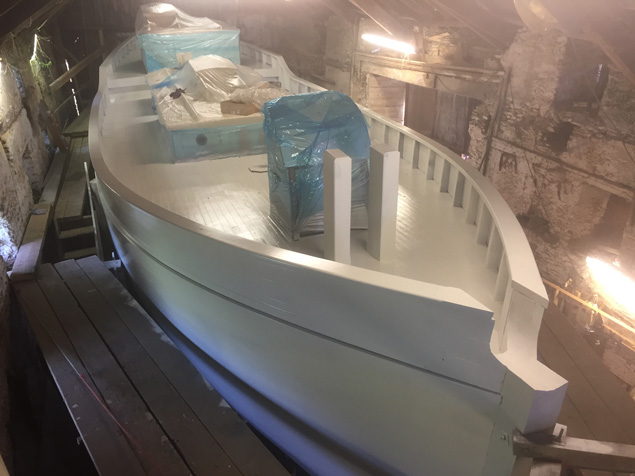 A sailing ship reduced to her absolute basics by no more than the application of a coat of primer paint. Photo: Gary MacMahon
A sailing ship reduced to her absolute basics by no more than the application of a coat of primer paint. Photo: Gary MacMahon
Conor O’Brien Ketch Ilen’s Deck to Be Completed By Mid-October
The re-decking of the 57ft Conor O’Brien ketch Ilen (originally built Baltimore 1926) is the latest stage of this major restoration/re-build project to be nearing completion at Liam Hegarty’s boatyard at Oldcourt on the Ilen River between Skibbereen and Baltimore writes W M Nixon. It is expected that the deck will be signed off by October 15th, and work will then proceed on more detailed work.
As part of the project, the new bowsprit – built by trainees in the Ilen Boat-building School in Limerick – was delivered down to Oldcourt last Saturday, and Ilen School Director Gary MacMahon reports a magic moment when Baltimore sailing legend Dermot Kennedy, owner himself of a similar ketch the Richard, called by Oldcourt on Saturday to give the deck his blessing and welcome the bowsprit to West Cork.
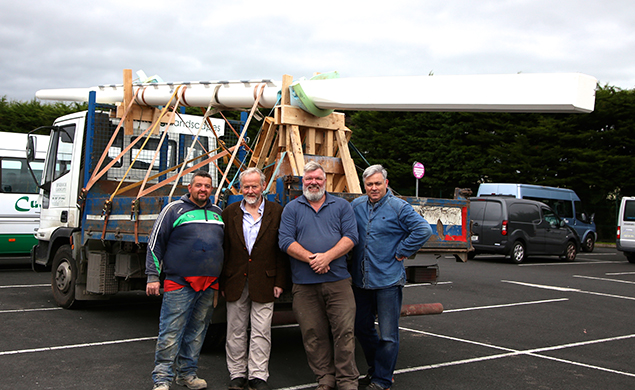
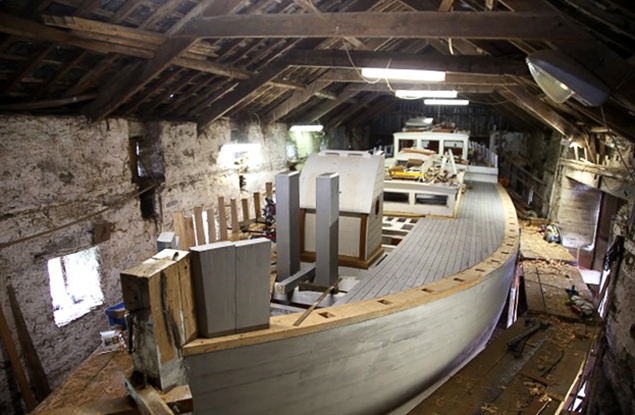 Combined effort. While the hull and deck of the Ilen have been re-constructed in the boatyard at Oldcourt in West Cork, all the deckhouses and hatches have been built in the trainee workshops of the Ilen Boat-Building School in Limerick. Photo: Gary MacMahon
Combined effort. While the hull and deck of the Ilen have been re-constructed in the boatyard at Oldcourt in West Cork, all the deckhouses and hatches have been built in the trainee workshops of the Ilen Boat-Building School in Limerick. Photo: Gary MacMahon
All the deckhouses, hatchways and similar “cabinet” work in the Ilen project has been done in Limerick and then trucked to Oldcourt. There, the main part of the hull and deck re-building has been progressing steadily, sometimes drawing on the talents of international traditional boat-builders who have been enticed to the magnet of West Cork by the quality and scale of the workmanship being produced by Liam Hegarty and his team.
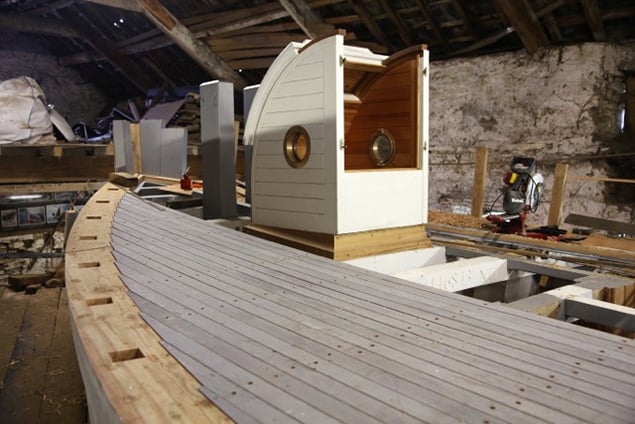 While you wouldn’t expect to find a forehatch like this on a modern offshore racer, on the traditional ketch Ilen the new Limerick-built forehatch housing looks very much at home. Photo: Gary MacMahon
While you wouldn’t expect to find a forehatch like this on a modern offshore racer, on the traditional ketch Ilen the new Limerick-built forehatch housing looks very much at home. Photo: Gary MacMahon
IIen was originally commissioned in 1925 by the Falkland Islanders to be their inter-island communications vessel after they had been properly impressed by her smaller sister, Conor O’Brien’s own-designed 42ft ketch Saoirse, which called to the Falklands in 1925 after rounding Cape Horn during his pioneering global circumnavigation.
O’Brien agreed to be involved with the Ilen project with Tom Moynihan the master shipwright of Baltimore, and then when the vessel was completed, her sailed her out to the Falklands. Because his only qualification was as a yachtmaster, for the delivery voyage the Ilen had to be registered as a yacht for insurance purposes, and she made the voyage under the burgee of the Royal Irish Yacht Club.
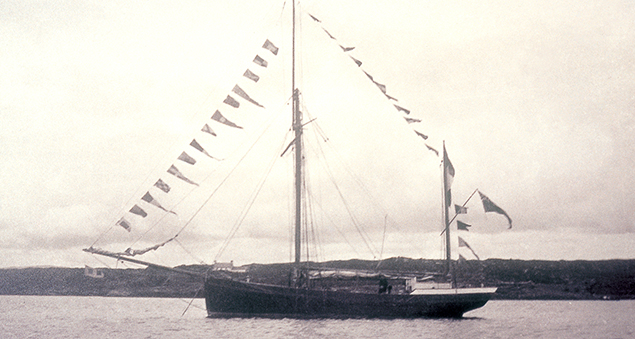 The Ilen on her launching day at Baltimore, 1926. She had to be registered as a yacht for insurance purposes, as her skipper Conor O’Brien’s only qualification was as a yachtsmaster, so he made the delivery to Ilen’s new owners in the Falkland Islands sailing under the burgee of the Royal Irish YC. This also obliged him to carry the RIYC’s then-recognised British blue ensign. But a look at this photo soon reveals the Irish ensign under the bowsprit, celebrating the fact that in making his 1923-25 circumnavigation with Saoirse, Conor O’Brien became the first captain to sail on any major voyage under the Irish tricolour
The Ilen on her launching day at Baltimore, 1926. She had to be registered as a yacht for insurance purposes, as her skipper Conor O’Brien’s only qualification was as a yachtsmaster, so he made the delivery to Ilen’s new owners in the Falkland Islands sailing under the burgee of the Royal Irish YC. This also obliged him to carry the RIYC’s then-recognised British blue ensign. But a look at this photo soon reveals the Irish ensign under the bowsprit, celebrating the fact that in making his 1923-25 circumnavigation with Saoirse, Conor O’Brien became the first captain to sail on any major voyage under the Irish tricolour
#woodenboats – In the annals of Irish seafaring, whether professional or amateur, only a very few can match the achievement of Conor O'Brien (1880-1952). Between 1923 and 1925, this multi-talented sailor from Foynes on the Shannon Estuary circled the world south of the Great Capes in the 42ft ketch Saoirse which he'd designed himself with the help of Tom Moynihan of the Baltimore Fisheries School Boatyard.
It was there that this unique vessel was built in 1922-23 as Ireland in general – and West Cork in particular – recovered from a short but brutal Civil War. The very fact that Saoirse was built in Baltimore, followed by the successful completion of her great voyage, became part of the slow post-war healing process. So as the 2015 Traditional and Classic Boat Season gets under way this weekend with the Baltimore Wooden Boat Festival, W M Nixon voices the hope that Saoirse – which had been feared totally lost since 1979 – may be re-born.
They're hardy sailors in West Cork. That lotus-land of easygoing cruising may seem a gentle place in high summer, yet down there they've felt the recent summer-delaying cold spell as sharply as anywhere else. But despite the unfavourable conditions, as usual in this last full weekend of May we'll see the Baltimore Woodenboat & Seafood Festival swing into action. And although wooden boats need reasonably good springtime weather almost as an essential for the annual refit, there'll be a colourful turnout of character vessels large and small.
But the talk of the town will not be about a boat which is showing her style off the busy Baltimore waterfront today. Indeed, not only will this very special boat not be there, but it's a moot point as to whether she still exists. Put another way: Does enough of Saoirse still exists to allow a re-creation of this wonderful little ship to be properly classified as a re-build?
The voyage of the Saoirse in 1923-1925 only gains further lustre and wonder with the passage of time. It was an achievement of greatness, yet of beautiful simplicity. It was a uniquely pioneering venture made by an Irish skipper in an Irish designed-and-built vessel, and it was the first major voyage by an Irish ship of any size flying the Tricolour ensign of the new-born nation.
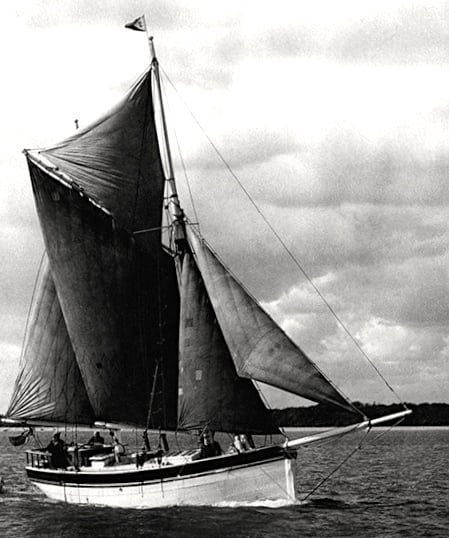
Saoirse under her original ketch rig in the 1950s, but with a boom fitted to the mainsail. Conor O'Brien had a loose-footed mainsail, and as evidenced here, the sail would have set much better but would have needed more attention in handling. (From a photo by Eric Hiscock)
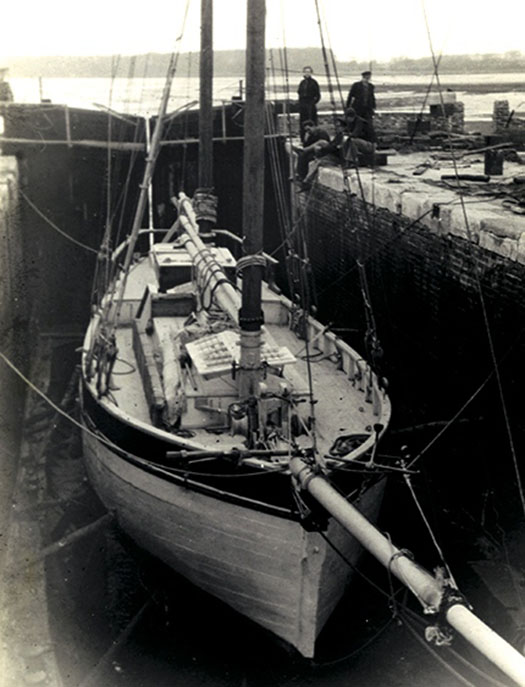
In dry dock during the 1950s, Saoirse's "cod's head & mackerel tail" hull shape is clearly seen. Yet in the Great Southern Ocean on her voyage round the world south of the Great Capes, this bluff little 42ft ketch regularly logged 180 miles a day in comfort.
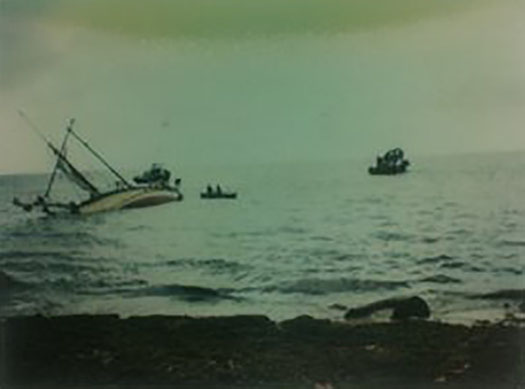
The wreck of the Saoirse in Jamaica, 1979.
Thus when the news in 1979 of Saoirse's destruction in a hurricane in Jamaica was confirmed, if anything it added to the legend. But it also meant that the only other boat created by the same team in the same place – the 56ft trading ketch Ilen (1926) – acquired added significance. But she was a long way away, still working the stormy seas around the Falkland Island, for which she'd been built after the islanders had been so impressed by the capabilities of the Saoirse, when she called there after rounding Cape Horn from the west, that they ordered a bigger sister-ship to become the inter-island workboat .
Yet thanks to a totally single-minded approach by Gary MacMahon of Limerick, Ilen was brought back to Ireland in 1998. And though it has taken quite a while for the various ideas to become reality, she is now well on the way to what has become a very public restoration with Liam Hegarty at Oldcourt Boatyard near Baltimore, while the Ilen Boatbuilding School in Limerick has become part of the fabric of Shannonside life, building not only the deckhouses and spars for Ilen herself, but an interesting selection of smaller boats ranging from traditional Shannon gandelows to the new CityOne sailing dinghies.
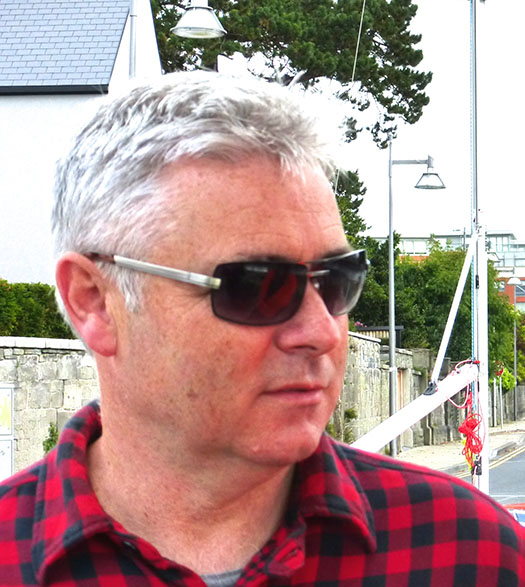
A man who just doesn't give up. Gary MacMahon of the Ilen School in Limerick. Photo: W M Nixon
By any standards, all these projects would be remarkable achievements in themselves. But in addition to his day job running one of Limerick's leading design studios, Gary MacMahon has for twenty years and more been quietly accumulating every bit of documentation of all sorts there is to be found relating to Saoirse.
It's an absolute treasure hoard of old photographs, certificates, plans, artefacts and other materials. And through this collecting, he has become well acquainted with Anthony Bolton who was Saoirse's last owner. Bolton had the misfortune of seeing his beloved boat destroyed by a hurricane in Jamaica before rescue attempts could save her after she'd dragged her anchor and gone ashore.
But though Saoirse was broken up by the battering of the hurricane, substantial pieces of her remained on the sea bed, and two sea-worn iron hanging knees – lovingly fitted by the Baltimore shipwrights 93 years ago – have recently been confirmed as definite relics of the wonderful little ship.
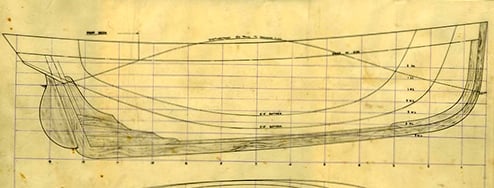
The hull lines of Saoirse as taken off by Uffa Fox in Cowes in 1927 before the start of that year's Fastnet Race (from which she retired, as endless windward work was not what she was designed for). Thanks to documentation of this quality, it will be possible to re-build Saoirse with precision. But in fact it has emerged that, such was the skill of Tom Moynihan and his boatbuilders in Baltimore in 1922-23, Saoirse as built very accurately followed the original lines drawn by O'Brien and Moynihan.
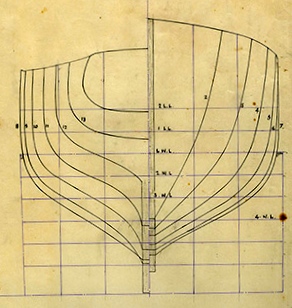
Saoirse's hull sections as recorded by Uffa Fox in 1927.
More importantly, though, the word is that much of the keel may still be intact. So just as he somehow got himself to the Falkland Islands to buy Ilen back in 1997, Gary MacMahon will shortly be going on the much easier journey to Jamaica for some real on-the-spot research as to just how much of Saoirse survives.
These days, it need only be a very small piece of the original to count as a re-build. But the spirit of the Ilen School is such that even if they find nothing at all in Jamaica, the notion of re-creating Saoirse is gaining so much traction, with that great shipwright Liam Hegarty among those totally taken with the idea of seeing Conor O'Brien's characterful little masterpiece sail again, that already the idea has acquired its own momentum.
But there'll be time enough when winter comes around again to give proper attention to the full range of Saoirse material which Gary MacMahon has amassed in order to ensure an authentic re-build. Meanwhile, this weekend may be seeing the new classic and traditional boat season kick into action in Baltimore, but already things are well under way in France, with last week's huge gathering in the Morbihan on the Biscay Coast, to which seven Dublin Bay Waterwags travelled, and eight returned.
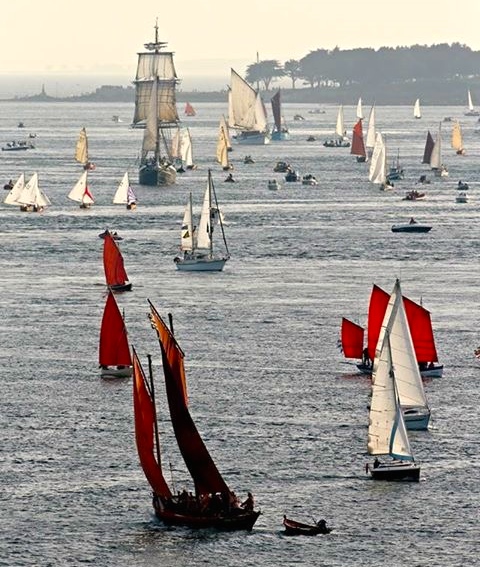
The wonders of the Morbihan. A very small part of the fleet at the Sailing Week eight days ago, with four of the Dublin Bay Water Wags at mid left. Photo: Courtesy Judith Malcolm
Like all the great French classic and tradboat festivals, the Morbihan event (it's full title is La Semaine de la Voile du Golfe de Morbihan, that's Morbihan Sailing Week in simple English) was mind-bending in terms of numbers, with 1200 boats of all shapes and sizes taking part. But the scale and layout of the Morbihan is such that it could well cope. The extensive inlet has six main ports, so the fleet was divided into six sub-groups of around 200 boats each. Everyone mingled out on the water during the day, then each night of the week-long festival saw your group going to a new port.
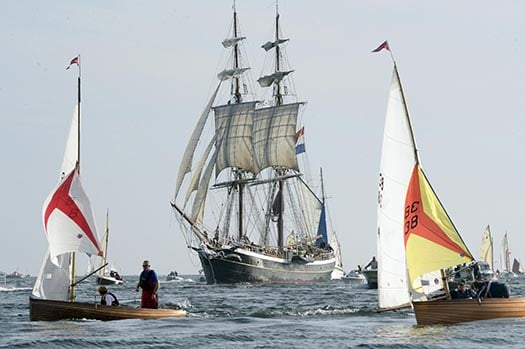
Two little Water Wags a long way from home – Ian & Judith Malcolm in the hundred year old Barbara (left) and Guy and Jackie Kilroy in Swift (right) in the midst of "sundry boats" in the Morbihan eight days ago. Photo courtesy Judith Malcolm
It worked, and it worked so well that the Irish flotilla of one Shannon One Design (Reggie Goodbody) and seven Water Wags not only had themselves a fine old time, but in a reversal of the usual story where our people return from distant places short of a boat or two, they came back with eight Wags, as Adam Winkelmann was united with his new boat. It was built in France as a boat-building academy exercise with a finish so exquisite that it was on exhibition in a marquee, but he was allowed to bring it home with him to Dublin Bay.
Far to the southwest in Baltimore, today we'll see a complex programme, as several traditional rowing craft (including a 23ft traditional Shannon cot or brochaun, the latest creation of Limerick's Ilen School built by a team headed by Tony Daly) were due to launch last night to berth at the pontoon in Skibbereen beside the West Cork Hotel. Today at 11am they start a rowing race all the way down the Ilen to Baltimore. Fortunately, the tide is ebbing.....
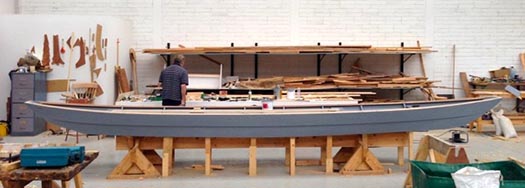
The new 23ft Shannon cot or brochaun is the latest creation of the Ilen School in Limerick. The cot's usual task was to head upriver from Limerick to fish, but today this boat will be rowed down the River Ilen from Sibbereen to the Baltimore Woodenboat Festival.
The rest of the day will see sailing and rowing races off Baltimore with a prize-giving dinner tonight in Baltimore Sailing Club presided over by Tom MacSweeney of this parish, then tomorrow (Sunday), as the one day Seafood Festival gets into full swing, there's perhaps the most interesting event of all afloat. This is the Pilot Race, in which the sailing boats put out to sea, and then turn and approach the harbour to be met by racing gigs each of which has to put a pilot on board one of the sailing craft which then race back into the harbour – it all makes for mighty sport.
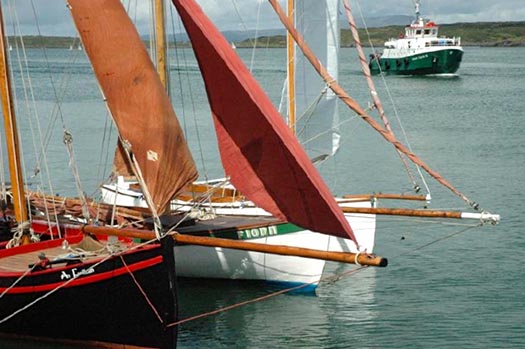
Bowsprits at the ready, and the island ferry coming into port – it can only be Baltimore at Woodenboat Festival time
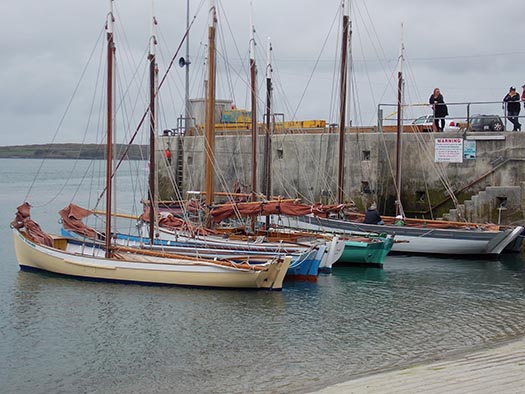
If you can identify even half of the boat types here, then you should be in Baltimore this weekend.
If your heart is with classic and traditional sailing boats, you can get an abundance of them by being in Baltimore this weekend, and then by being along Dublin's Liffey for the Riverfest in a week's time for the Bank Holiday weekend. It's a three day event (May 30th to June 1st) based on Poolbeg Y & BC, with the Old Gaffer's Leinster Trophy Race in Dublin Bay on Saturday, and then two days above the bridge for all sorts of city festivities and boat parades through to Monday evening.
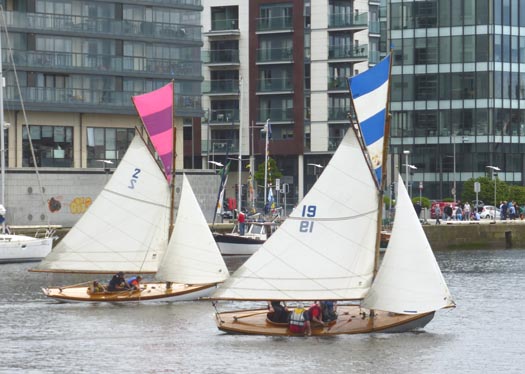
The 117-year-old Howth 17s will be returning to the Dublin Riverfest in a week's time. Photo: W M Nixon
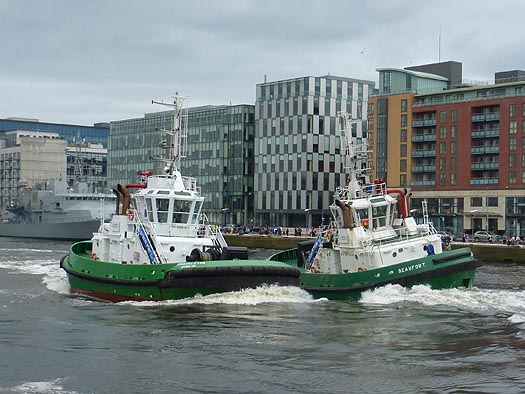
The famous waterborne ballet of the Dublin Port tugs Shackleton and Beaufort will be a main event in the Dublin Riverfest over the Bank Holiday Weekend of May 31st-June1st. Photo: W M Nixon
Following that, on Saturday 6th June out in Howth, the Classic Lambay Race is being provided within the annual Round Lambay Regatta (it dates back to 1904), with the Old Gaffers and Traditional boats joining the 117-year-old Howth Seventeens for a direct circuit from a pier start out to Lambay, round it and back again direct, with no fancy special mark rounding in between.
Defending champion in the Classic Lambay is OGA International President Sean Walsh of Dun Laoghaire with his cutter Tir na nOg, and extra interest is added this year as the fleet will include Dickie Gomes' 1912-vintage 36ft yawl Ainmara, built in Ringsend but now a longtime resident of Strangford Lough. There's a certain edge to Ainmara's involvement, as she was overall winner of the cruiser division in the 1921 Lambay Race when still owned and sailed by her designer-builder John B Kearney. But if you think this remarkable historic link will cause her opponents to give her an easy time of it, you're much mistaken.
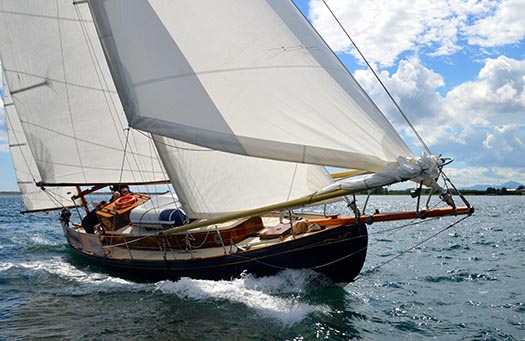
The 103-year old Ainmara – seen here on her home waters of Strangford Lough with the Mourne Mountains in the distance – will be returning to the Lambay Classic at Howth on June 6th 2015, which she last won in 1921. Photo: Pete Adams
Sean Walsh is having a busy year of it, as his duties as OGA President take him hither and yon, while Tir na nOg will be flagship for the OGA Cruise-in-Company which will follow the big one of 2015, the Glandore Classics Regatta from July 18th to 24th.
But for this weekend, he's in his home waters of Dublin Bay on a venture which means a lot to him, the OGA Youth Sailing Project at Poolbeg under the direction of Liam Begley. It's for youngsters who might not otherwise get a chance to sail. They're taken out to learn the ropes aboard two fine gaff cutters, the Clondalkin Community group's majestic Galway Bay hooker Naomh Cronan, and the OGA President's own Tir na nOg.
When we remember that many folk head from Dublin towards Cork to go sailing, it's intriguing that in this case the young people have come the other way, as they're a group from Mayfield Community School which has eternal fame through being the old school of Roy Keane.
The tyro sailors from Mayfield – there's nine of them, all in the 15-16 age group - have already become boat-acquainted through the Meitheal Mara Community Boatyard in Cork city. But the outing to Dublin puts a different spin on it all, as the first stage is devoted literally to teaching them the ropes, then after the sailing programme is completed out in the bay, the shift in skills is demonstrated by command of the two gaff cutters being given over to the Mayfield crews, who then have to sail them back to port.
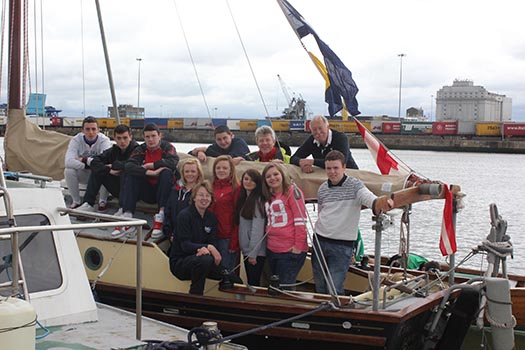
OGA President Sean Walsh (top right) with Junior Gaffers from Mayfield Community School in Cork aboard Tir na nOg in Poolbeg in Dublin. Photo: John Galloway
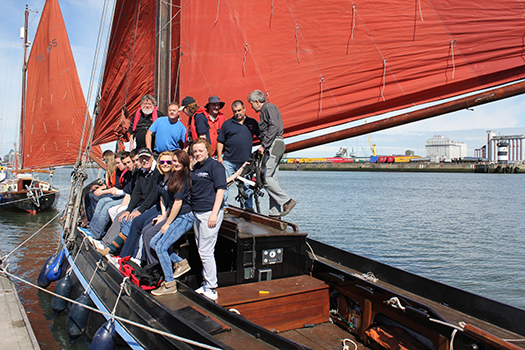
Junior Gaffers from Cork and Senior Gaffers from Dublin aboard the Naomh Cronan Photo: John Galloway
In all, it's an entertaining balance between an outing to Dublin, a chance to learn in a fun environment, and a real opportunity to demonstrate that practical skills have been well and truly acquired. And before somebody is driven to send in a rude comment after seeing these two photos of last year's Youth Sailing Project course, I hasten to assure you that when they do go sailing, everyone wears a lifejacket.


























